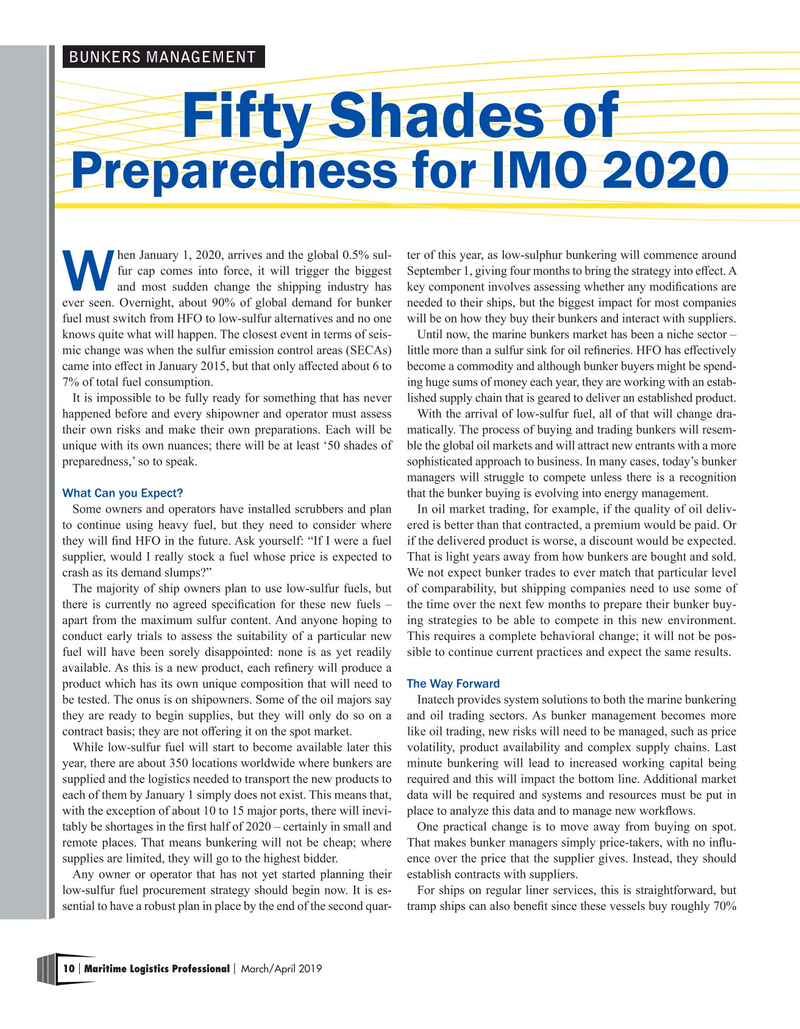
Page 10: of Maritime Logistics Professional Magazine (Mar/Apr 2019)
Container Ports
Read this page in Pdf, Flash or Html5 edition of Mar/Apr 2019 Maritime Logistics Professional Magazine
BUNKERS MANAGEMENT
Fifty Shades of
Preparedness for IMO 2020 hen January 1, 2020, arrives and the global 0.5% sul- ter of this year, as low-sulphur bunkering will commence around fur cap comes into force, it will trigger the biggest :/ +4+ # + # + !"
W and most sudden change the shipping industry has $ / 4 4#####+ # ever seen. Overnight, about 90% of global demand for bunker needed to their ships, but the biggest impact for most companies fuel must switch from HFO to low-sulfur alternatives and no one will be on how they buy their bunkers and interact with suppliers.
knows quite what will happen. The closest event in terms of seis- < $#$ ## 3 mic change was when the sulfur emission control areas (SECAs) # #$ #!# 4 become a commodity and although bunker buyers might be spend- 7% of total fuel consumption. ing huge sums of money each year, they are working with an estab-
It is impossible to be fully ready for something that has never lished supply chain that is geared to deliver an established product.
happened before and every shipowner and operator must assess With the arrival of low-sulfur fuel, all of that will change dra- their own risks and make their own preparations. Each will be matically. The process of buying and trading bunkers will resem- unique with its own nuances; there will be at least ‘50 shades of ble the global oil markets and will attract new entrants with a more preparedness,’ so to speak. sophisticated approach to business. In many cases, today’s bunker managers will struggle to compete unless there is a recognition
What Can you Expect? that the bunker buying is evolving into energy management.
Some owners and operators have installed scrubbers and plan In oil market trading, for example, if the quality of oil deliv- to continue using heavy fuel, but they need to consider where ered is better than that contracted, a premium would be paid. Or !"#$ #&'** if the delivered product is worse, a discount would be expected. supplier, would I really stock a fuel whose price is expected to That is light years away from how bunkers are bought and sold. crash as its demand slumps?” We not expect bunker trades to ever match that particular level
The majority of ship owners plan to use low-sulfur fuels, but of comparability, but shipping companies need to use some of # +#/ # #3 the time over the next few months to prepare their bunker buy- apart from the maximum sulfur content. And anyone hoping to ing strategies to be able to compete in this new environment. conduct early trials to assess the suitability of a particular new This requires a complete behavioral change; it will not be pos- 4# #// & ## sible to continue current practices and expect the same results.
4!"# ##/ / product which has its own unique composition that will need to The Way Forward be tested. The onus is on shipowners. Some of the oil majors say Inatech provides system solutions to both the marine bunkering they are ready to begin supplies, but they will only do so on a and oil trading sectors. As bunker management becomes more ##6 + #/ $ ! like oil trading, new risks will need to be managed, such as price
While low-sulfur fuel will start to become available later this volatility, product availability and complex supply chains. Last year, there are about 350 locations worldwide where bunkers are minute bunkering will lead to increased working capital being supplied and the logistics needed to transport the new products to required and this will impact the bottom line. Additional market each of them by January 1 simply does not exist. This means that, data will be required and systems and resources must be put in with the exception of about 10 to 15 major ports, there will inevi- / = # + $> #!
# +# # 3 # One practical change is to move away from buying on spot. remote places. That means bunkering will not be cheap; where @ $# $+##//B $# > - supplies are limited, they will go to the highest bidder. ence over the price that the supplier gives. Instead, they should
Any owner or operator that has not yet started planning their establish contracts with suppliers.
low-sulfur fuel procurement strategy should begin now. It is es- For ships on regular liner services, this is straightforward, but sential to have a robust plan in place by the end of the second quar- /#/## # #4### +DG 10 Maritime Logistics Professional March/April 2019 | |

 9
9

 11
11
